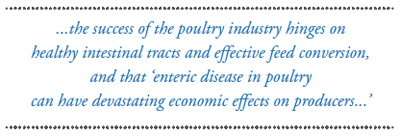

Supplemental bacitracin reduces mortality, C. perfringens in broilers

Commercial broilers that received a bacitracin-supplemented diet had less Clostridium perfringens in their gut1, according to researchers at Ohio State University.
In their study, repeated with three flocks, the investigators evaluated the interaction between fresh versus reused litter and dietary bacitracin supplementation on the prevalence and load of Clostridium perfringens, Salmonella spp. and Campylobacter spp. — all foodborne enteric pathogens commonly associated with poultry. C. perfringens is also a cause of necrotic enteritis, a costly disease for the broiler industry.
Newly hatched chickens that had been vaccinated for coccidiosis were assigned to one of four treatment groups: fresh pine shavings and no dietary bacitracin, fresh litter and bacitracin at 0.04% of feed, reused litter and no dietary bacitracin or reused litter and 0.04% dietary bacitracin.
At 10 and 35 days of age, the researchers tested samples from the ileal mucosa, cecal content and litter using specific quantitative polymerase chain reaction assays. Campylobacter was not detected in the samples.
The amount of Salmonella was not affected by bacitracin, and reused litter did not contain significantly more C. perfringens or Salmonella. There was a correlation, however, between an abundance of Salmonella spp. and C. perfringens, say Shan Wei, PhD, and colleagues in the Oct. 25, 2013, issue of Veterinary Microbiology.

More Issues












